With training camp around the corner, the 2019 NHL Entry Draft’s first and second overall picks Jack Hughes and Kaapo Kakko are poised to make an impact this season. However, a few other candidates can and most likely will surprise.
The top four from the 2018 draft class, Rasmus Dahlin, Andrei Svechnikov, Jesperi Kotkaniemi, and Brady Tkachuk all played significant NHL minutes last season, with considerable impact. Aside from those players, Filip Zadina (6th), Quinn Hughes (7th), Evan Bouchard (10th), and Isac Lundestrom (23rd) all had a cup of coffee in the NHL.
Jack Hughes
Jack Hughes has long been considered the best prospect from the 2019 draft and on June 21, he became the first overall selection. Jack, like his brother Quinn, is an incredible skater with dynamic talent. He is already among the best skaters in the world with his shifty edge-work and elusiveness. Some questioned if he needed another year of playing against men due to his slight frame (5-foot-10, 170 lbs) but the New Jersey Devils quickly halted that narrative by signing Hughes to an entry-level contract (ELC). The USNTDP product looks to prove doubters wrong next season.
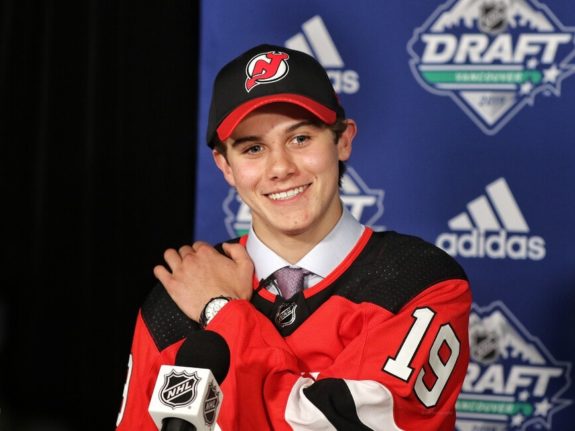
Due to Hughes’ frame, I would not expect him to dominate right away. At the 2019 IIHF World Championship, he represented the USA along with other notable NHLers where centered his idol, Patrick Kane, and was relatively disappointing. Hughes showed occasional flashes of his heralded elite play-making ability but looked physically overwhelmed. This season, expect him to mainly see time with KHL star Nikita Gusev on the second line as center Nico Hischier will likely play alongside Taylor Hall again. Expectations should be around 55-65 points, the wide gap because Gusev is a wild card. Hughes won’t dominate in all areas just yet, but he’ll do what he does best: put up points.
Kaapo Kakko
Kakko really started turning heads at the World Junior Championships as a legitimate contender for Hughes’ number one spot. He scored the golden goal for Finland to defeat Hughes’ Team USA, which sparked the debate. Hughes (Devils) and Kakko (New York Rangers) also landed with teams who have a longstanding rivalry, so naturally they will be compared and pitted against each other for years to come. However, Kakko may be more NHL ready than Hughes. I may be in the minority, but I believed Kakko was the best player in the draft.
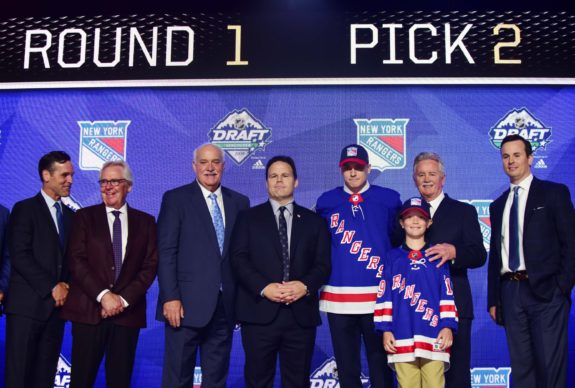
Kakko’s game revolves around power and puck protection. At 6-foot-2, 190 lbs, his frame was well-utilized in the Finnish Liiga this past season against men, unlike Hughes. He is already among the best in the world at shielding the puck and using his back to brush off the opposition, along with dynamic cuts and turns that make it almost impossible to cleanly strip him off the puck.
At the World Juniors, Kakko scored 6 goals and 7 points in 10 games, finishing second on his team. Unlike Jack Hughes, Kakko has filled into his 6’2 frame so expect him to fit in well in the NHL. Due to the Rangers young roster, Kakko does not have a set spot in the lineup, though he’s expected to compete with Vitaly Kravtsov (9th, 2018) for the second line right wing spot. I expect around 25 goals and 60 points from Kakko, though he should look more comfortable and physically-adept than Hughes in their rookie season.
Kirby Dach
The 3rd overall selection in the 2019 NHL Entry Draft, Dach was a bit of a surprise to anyone expecting the Chicago Blackhawks to take Alex Turcotte (5th), a local kid who looked up to and plays like Blackhawks captain and elite center, Jonathan Toews. Dach was a consensus top-10 pick but some felt that his inconsistencies and almost lackadaisical play throughout the WHL season would have made him drop a few spots. He is a big right-handed center at 6-foot-4, 198 lbs who can slow the game down and take over, using his incredible vision and puck-handling abilities to create plays for his teammates, which has drawn comparisons to Ryan Getzlaf.
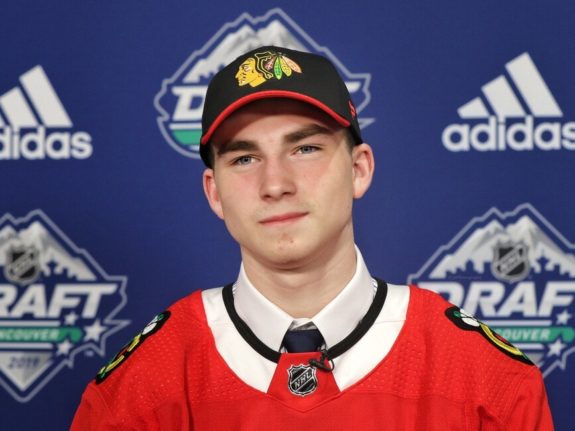
Dach may need another year with Saskatoon of the WHL to refine his game and skating a bit more, but expect him to get the standard nine NHL games. As for his WHL season, he should crack 100 points and lead his team to the playoffs again.
Bowen Byram
The Colorado Avalanche’s 4th overall selection in 2019, acquired in the Matt Duchene trade, was unanimously named the best defenseman available. Some wondered if Colorado would go for a center to fill the hole behind superstar Nathan MacKinnon, namely Alex Turcotte when he “fell” to fourth, but the Avs opted for the all-around left-handed defenseman to partner with fellow elite prospect and right-hand defenseman, Cale Makar. The Avalanche later acquired their number two center in a deal that saw Colorado acquire Nazem Kadri, Calle Rosen, and 2020 third-round pick from Toronto in exchange for Tyson Barrie, Alex Kerfoot, and a 2020 sixth-round pick.
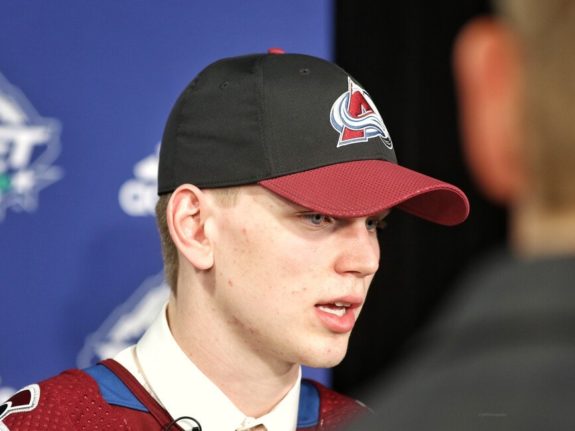
Byram, an agile puck-moving defenseman at 6-feet, 194 lbs, excels in every aspect of the game and while he may not have the flashiest upside, he can log heavy minutes in crucial situations, as he showed in the playoffs for the Vancouver Giants of the WHL. He was above a point-per-game at 71 points in 67 games during the regular season, good for second in team scoring and third among WHL defensemen. However, it was his WHL playoffs that solidified Byram as a consensus top-5 pick when he logged heavy minutes and was dominant whenever he took the ice and developed a grittier side.
Without Barrie, the Avalanche may have a spot for Byram on the blue line. They will likely let him play the nine games to prove himself over offseason addition Kevin Connauton who was acquired from the Arizona Coyotes along with a 3rd-round pick for Carl Soderberg. If Byram sticks in the NHL, don’t expect him to jump in and start producing from the get go. Defensemen typically take longer to reach their potential as we saw with Dahlin last season, who struggled defensively early on. If not this season, expect Byram to push for a top-four spot in 2020-21.
Dylan Cozens
The Buffalo Sabres selected the 6-foot-3, right-handed center from the Yukon with their 7th overall selection. I don’t believe Cozens should be playing in the NHL next season, he seems to believe he can. Potting 34 goals and 84 points in 68 games last season for Lethbridge, the lanky center possesses blazing fast speed for his size along with a hard, deceptive shot. If he is rushed to the NHL, I cannot imagine him succeeding. In the WHL, he benefited from his size and speed but he seems to have no direction. When the ice gets smaller and Cozens has less room to skate he struggles, as his hands and IQ are not elite. Usually in this situation, he’ll try to spin off the defender or force a badly-timed pass.
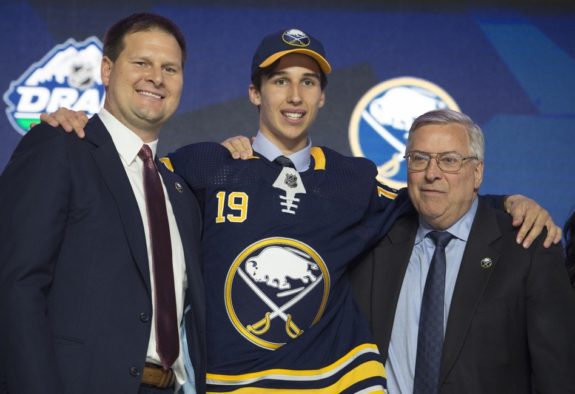
Cozens will likely see nine games at the start of the season due to a middle-six center spot being up for grabs. He also will likely go back to Lethbridge for one more season before making the jump. While I’m not his biggest fan (ranked 18th), his upside and tools are undeniable and his play is similar to Mika Zibanejad. Zibanejad was also an “all tools” player whose effort was inconsistent and his IQ was questionable until he broke out last season.
Victor Soderstrom
The Arizona Coyotes’ 11th overall selection in the 2019 draft received high praise from general manager John Chayka, who stated that he considered Soderstrom as the third best prospect in the draft. This surprised fans who considered him a pick in the 10-15 range. Chayka traded up from 14th to 11th with the inclusion of a second-round pick. Soderstrom is a 6-foot, 182-lb, right-handed, two-way defenseman who logged important top-4 minutes with Brynäs IF of the SHL during the regular season and playoffs.
He didn’t put up gaudy offensive numbers in the SHL, that’s not his game. He is a rounded defenseman who typically opts for the safer play; catching him out of position is tough to do. That’s not to say he can’t move the puck though, Soderstrom can start the rush from the back end and has an excellent first pass.
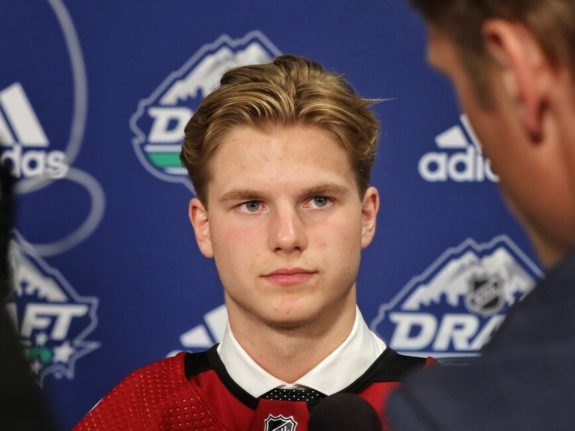
Coyotes signed Soderstrom to an ELC shortly after drafting him and have decided to give him a shot at making the team this season. the Coyotes have long been rebuilding and last season they took a step forward by barely missing the playoffs. Soderstrom fills one of the team’s biggest needs in a top-4 right-handed defenseman, and while he may not be able to step into that role immediately, he may be able to handle bottom pairing minutes. He impressed with important minutes against men, so it wouldn’t be a shock to see him stay on Arizona’s blue line for an extended period. He will need to improve his strength though.
NCAA Draftees Who Could See NHL Time Once Their Season Is Up
Alex Turcotte (5th overall selection by the Los Angeles Kings)
Trevor Zegras (9th overall selection by the Anaheim Ducks)
Matt Boldy (12th overall selection by the Minnesota Wild)
Cam York (14th overall selection by the Philadelphia Flyers)
Cole Caufield (15th overall selection by the Montreal Canadiens)
Alex Newhook (16th overall selection by the Colorado Avalanche)
While none of the players listed are guaranteed to make their respective teams opening night roster, they will all receive extended looks in pre-season barring injury. Surprises can happen as well, such as Isac Lundestrom (23rd, 2018) making the Ducks opening roster last season or Filip Chytil (21st, 2017) earning a call-up from the Rangers during the 2017-2018 season. The biggest surprise I can see happening would be Tobias Bjornfot (22nd) after the Kings signed him to an ELC and refused to comment on where he’d be playing next season. If the Kings decide to keep the Swedish two-way defenseman in North America, he’d be playing for the Ontario Reign of the AHL. The Kings’ left side defense is already weak, and if injuries occur, Bjornfot may see himself as a call-up. That all depends on if he’s returning to Sweden for his draft-plus one year though. Aside from Hughes and Kakko, there are no guarantees for the rookies.